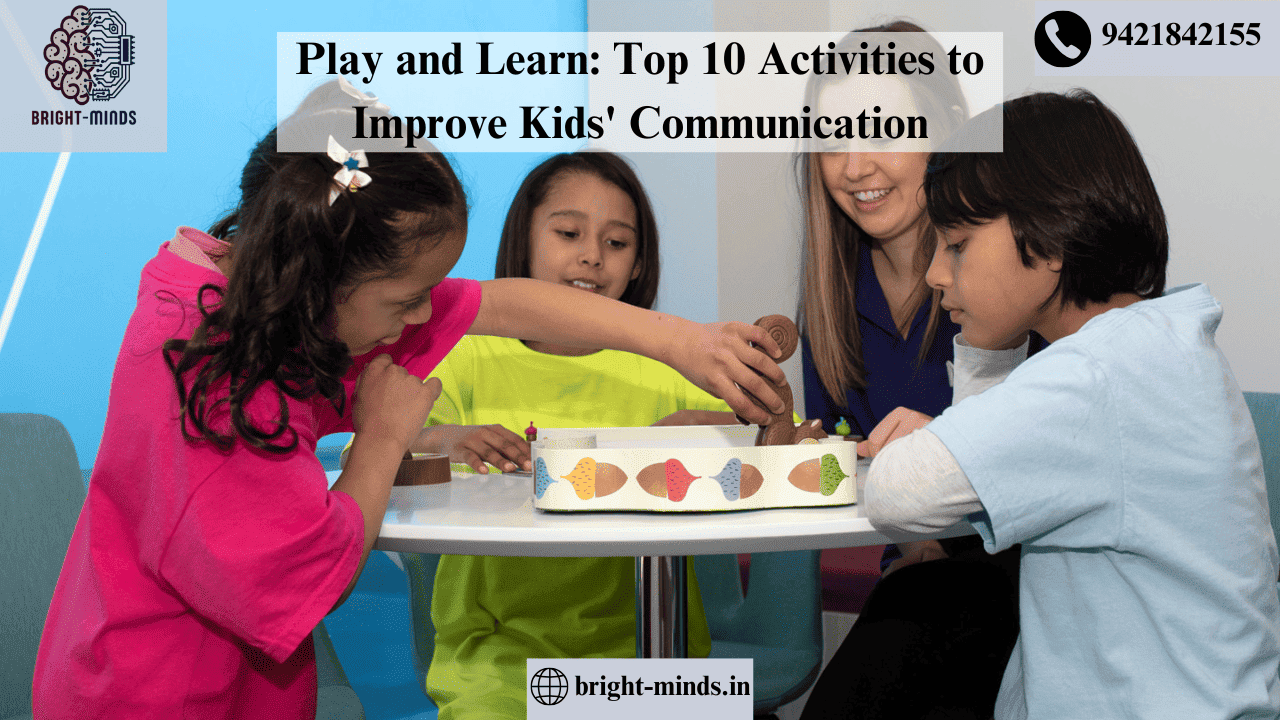Introduction: Communication is a cornerstone of a child’s development, impacting their relationships, academic success, and self-confidence. While teaching communication may seem daunting, incorporating fun and interactive activities into their daily lives can make learning seamless and enjoyable. This blog explores ten engaging activities that will help improve kids’ communication skills through play and learning.

1. Charades: Charades is a timeless game that fosters non-verbal communication and creativity. By acting out scenarios, kids learn to express ideas without words while enhancing their ability to read body language and emotions. To play:
- Write prompts on slips of paper (e.g., animals, activities, emotions).
- Have each child pick a slip and act out the prompt while others guess.
- Celebrate creative expressions and encourage group participation.
Why it works: Charades develops non-verbal communication skills, quick thinking, and teamwork.
2. The Telephone Game: This classic game teaches the importance of clarity and listening. In this activity, kids pass a whispered message around a circle, comparing the original message to the final one.
How to play:
- Form a circle and start with a simple sentence like “The dog is playing in the park.”
- Whisper the sentence to the next person, who passes it along until it reaches the last person.
- Have the final person say the message aloud to reveal how it’s changed.
Why it works: Kids learn to articulate their thoughts and actively listen to others, realizing how small misunderstandings can lead to miscommunication.
3. Role-Playing: Role-playing games allow children to step into different characters, fostering empathy and social skills. Whether pretending to be a shopkeeper, teacher, or astronaut, kids practice speaking and interacting in diverse scenarios.
How to play:
- Create a setup, like a mini store or classroom.
- Assign roles and provide prompts to guide the interaction.
- Encourage kids to switch roles and explore different perspectives.
Why it works: Role-playing enhances verbal expression, problem-solving, and adaptability in social settings.
4. Storytelling Circles: Collaborative storytelling is an excellent way to boost creativity and listening skills. Each child contributes a sentence to build a collective story.
How to play:
- Start with a sentence like, “Once upon a time, there was a magical tree.”
- Each child adds a sentence, continuing the story.
- Encourage imaginative twists and turns.
Why it works: This activity strengthens kids’ ability to listen, build on others’ ideas, and articulate their thoughts clearly.
5. Emotion Charades: Understanding emotions is critical for effective communication. Emotion charades helps children recognize and express feelings.
How to play:
- Write emotions (e.g., happy, sad, surprised, angry) on cards.
- Have each child act out an emotion while others guess.
- Discuss scenarios where these emotions might occur.
Why it works: Emotion charades enhances emotional intelligence and helps kids communicate feelings effectively.
6. Group Discussions: Facilitating group discussions on simple topics helps kids practice turn-taking and respect for diverse opinions.
How to play:
- Choose a topic like “What is your favorite animal?” or “What would you do if you had superpowers?”
- Encourage each child to share their thoughts while others listen.
- Guide the discussion to ensure everyone has a chance to participate.
Why it works: Group discussions build confidence, listening skills, and the ability to articulate ideas in a group setting.
7. Collaborative Art Projects: Art projects that require teamwork encourage kids to communicate their ideas and compromise.
How to play:
- Provide materials for a shared art project, like a large mural or collage.
- Assign roles (e.g., drawing, coloring, assembling) to each child.
- Encourage them to discuss their ideas and collaborate.
Why it works: Collaborative art promotes teamwork, problem-solving, and verbal expression.
8. Picture Guessing Game: This game involves drawing and guessing, sharpening verbal and descriptive skills.
How to play:
- One child draws an object, animal, or scene while others guess what it is.
- To make it challenging, the artist can’t speak while drawing.
- After guessing, discuss how descriptions could have been clearer.
Why it works: Kids learn to describe visuals effectively and enhance their listening skills.
9. Outdoor Scavenger Hunt: Take communication outdoors with a scavenger hunt. Kids must decipher clues to find items, encouraging critical thinking and teamwork.
How to play:
- Write clues that lead to specific objects (e.g., “I have leaves and grow tall. What am I?”).
- Pair kids into teams to solve the clues and find the items.
- Discuss the clues afterward to reflect on the process.
Why it works: Scavenger hunts teach problem-solving, teamwork, and effective communication.
10. “Would You Rather?”: This simple game involves answering fun and thought-provoking questions, encouraging kids to explain their reasoning.
How to play:
- Ask questions like, “Would you rather be able to fly or breathe underwater?”
- Encourage kids to elaborate on their answers.
- Facilitate a discussion on different viewpoints.
Why it works: “Would You Rather?” stimulates critical thinking, verbal expression, and respect for others’ opinions.
Conclusion: These ten activities provide a mix of fun, creativity, and learning to help kids develop essential communication skills. By incorporating these games into daily routines or classroom activities, parents and educators can create opportunities for children to grow socially and emotionally while having a great time. Strong communication skills pave the way for success in relationships, academics, and beyond—and the journey to mastering them can be enjoyable for everyone involved.
you may be interested in this blog here:-
Top-Rated Best Coaching Classes Near Me Personalized Attention & Engaging Learning!

